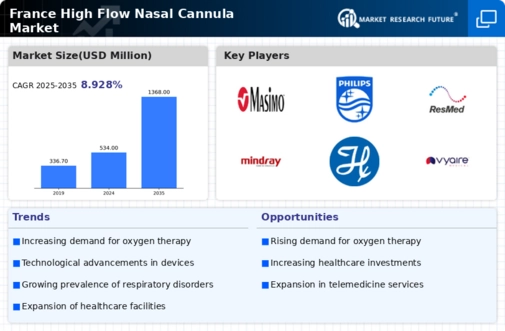Enhanced Patient Comfort and Compliance
Patient comfort and compliance are critical factors influencing the high flow-nasal-cannula market. Unlike traditional oxygen delivery systems, high flow nasal cannulas provide a more comfortable experience for patients, allowing for better tolerance during prolonged use. This is particularly relevant in hospital settings where patients require extended respiratory support. Studies indicate that patient satisfaction rates improve significantly with high flow-nasal-cannula systems, leading to better adherence to treatment protocols. As healthcare facilities in France prioritize patient-centered care, the demand for high flow-nasal-cannula systems is likely to rise. The market is thus positioned to expand as providers recognize the importance of comfort in enhancing overall treatment outcomes.
Rising Prevalence of Respiratory Disorders
The increasing incidence of respiratory disorders in France is a primary driver for the high flow-nasal-cannula market. Conditions such as chronic obstructive pulmonary disease (COPD) and asthma are becoming more prevalent, affecting a significant portion of the population. According to health statistics, approximately 3.5 million individuals in France suffer from COPD, which necessitates effective respiratory support. The high flow-nasal-cannula market is likely to benefit from this trend, as healthcare providers seek advanced solutions to manage these conditions. Furthermore, the aging population, which is more susceptible to respiratory issues, is expected to contribute to the demand for high flow-nasal-cannula systems. This demographic shift indicates a growing need for innovative respiratory therapies, thereby propelling the market forward.
Rising Awareness of Non-Invasive Ventilation
There is a growing awareness of non-invasive ventilation techniques among healthcare professionals and patients in France, which is positively impacting the high flow-nasal-cannula market. As medical practitioners increasingly recognize the benefits of non-invasive methods for managing respiratory distress, the demand for high flow-nasal-cannula systems is likely to increase. Educational initiatives and training programs are being implemented to enhance understanding of these technologies, leading to broader acceptance in clinical practice. This shift towards non-invasive solutions is expected to drive market growth, as healthcare providers seek effective alternatives to invasive procedures. The high flow-nasal-cannula market is thus positioned to thrive in this evolving landscape.
Technological Innovations in Respiratory Care
Technological innovations are a key driver of the high flow-nasal-cannula market, as advancements in design and functionality enhance the efficacy of respiratory care. Manufacturers are continuously developing new features, such as integrated humidification and precise flow control, which improve patient outcomes. The introduction of smart technologies, including real-time monitoring systems, is also gaining traction in the market. These innovations not only optimize treatment but also facilitate better management of respiratory conditions. As healthcare providers in France adopt these advanced solutions, the high flow-nasal-cannula market is likely to experience substantial growth, reflecting the ongoing evolution of respiratory care technologies.
Growing Investment in Healthcare Infrastructure
The high flow-nasal-cannula market is poised for growth due to increased investment in healthcare infrastructure across France. The government and private sectors are allocating substantial funds to enhance medical facilities, particularly in critical care and respiratory therapy. Recent reports suggest that healthcare spending in France is projected to reach €200 billion by 2026, with a significant portion directed towards advanced medical technologies. This investment is expected to facilitate the adoption of high flow-nasal-cannula systems, as hospitals upgrade their equipment to meet modern standards. Consequently, the high flow-nasal-cannula market stands to gain from this trend, as improved infrastructure supports the integration of innovative respiratory solutions.





















Leave a Comment